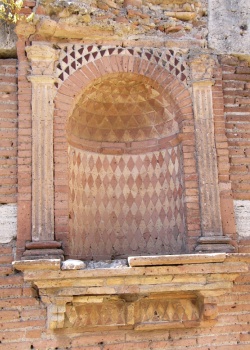Lararium
Home| Latíné | Deutsch | Español | Français | Italiano | Magyar | Português | Română | Русский | English
The Lararium (pl. lararia) altar is the sacred place of the home where offerings and prayers are made to the Gods. In more affluent Roman homes, such as private villas, the main Lararium altar was usually set in the Atrium (front reception room, near the front door). In smaller Roman homes which might not have an atrium, such as insula apartments, the Lararium was most often located near the hearth (the kitchen or place of a central fire). But a house could have several minor Lararia as well, indoors (specially in the bedrooms) or outdoors.
Contents |
Variety of Forms
The forms of Lararium varied greatly. Rich homes might have a huge affair of carved marble which looked rather like a temple in miniature. In other homes the Lararium might only be a simple wooden cabinet or wall shelf. Big or small, the important thing about a Lararium altar is that it should be permanent rather than something to be put away when the rites are not being held.
A lararium, properly speaking, is a shrine for your Lares alone, meaning your ancestors. During the Republic there does not seem to have been any statues used to represent the Lares, since they were considered more as ancestors. The death masks of ancestors were stored in boxes, hung on a wall near the entrance of the house, and it might possibly be that lararium meant something like a foyer where these were kept. Today it would be comparable to having photographs of your ancestors at your lararium. Beginning in the fourth century BCE certain patrician families assumed divine heritages and thus may have begun to include images of a Lar familiaris such as Venus, but these would still have been regarded there as an ancestor.
Making a Lararium
The easiest way to set up a Lararium is to reserve a small one-tier wall shelf, or a table or cabinet as an altar. A trip to a hardware store, a department store or an antique shop will usually yield something workable. A Lararium need not be any special style or color, if you like the look of it, it works! It's nice if one can place the Lararium in a front room or near the kitchen area as was done in history, but this is not essential. The important thing is that the Lararium be placed somewhere that isn't so remote that it will be ignored or forgotten, or in a place so obtrusive it gets bumped into and knocked about during the course of the day! One doesn't really need a lot of surface space for the altar. A square foot of space or so is about the average, as long as there is room for a candle, incense, and an offering dish. Space for statuary or wall space to hang pictures on is nice but not critical. The Lararium should be kept clean, and may be decorated to taste in Classical style if one wishes.
Examples
Ancient Lararia
